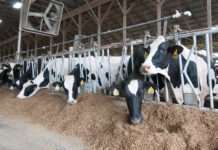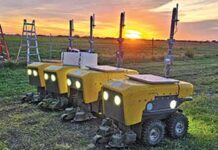LAWRENCE — A crew from the Kansas Geological Survey, based at the University of Kansas, will be in western Kansas in early January to measure groundwater levels in hundreds of wells. The work is part of an annual program with the Kansas Department of Agriculture’s Division of Water Resources (KDA-DWR) to determine if or how quickly groundwater is being depleted in different parts of western and central Kansas.
The KGS crew will be near Colby and Atwood on Jan. 2, 2016, Goodland and St. Francis on Jan. 3, Tribune, Syracuse and Ulysses on Jan. 4, Elkhart and Liberal on Jan. 5, and Meade and Dodge City on Jan. 6, weather permitting.
Most of the 568 wells on the KGS’s list have been measured for years, some since the 1960s. Nine new ones have been added to fill in spatial gaps in the network of wells.
“The KGS gets permission from the landowner before monitoring a new well,” said Brett Wedel, manager of the KGS water-level-data acquisition.
Of the 1,401 wells to be measured in 48 counties by the KGS and KDA-DWR, 90 percent draw water from the High Plains aquifer, a massive network of underground water-bearing rocks that underlies parts of eight states and includes the extensive Ogallala aquifer. It is the primary source of irrigation, municipal and industrial water for much of western and central Kansas.
The remaining 10 percent of the wells are drilled into the Dakota aquifer and other deeper systems or shallow alluvial aquifers along creeks and rivers.
Besides underlying much of western Kansas, the High Plains aquifer encompasses the Great Bend Prairie aquifer in west-central Kansas and the Equus Beds aquifer north and west of Wichita. KDA-DWR field offices will measure 833 wells in those central Kansas areas and parts of western Kansas. Of those, the Stockton field office will measure 224, the Garden City field office will measure 246, and the Stafford field office will measure 363.
Wells are measured in December, January and February to avoid short-term declines caused by pumping for irrigation during the previous growing season.
The majority of wells monitored by KGS and DWR are within the boundaries of the state’s five Groundwater Management Districts, which are organized and governed by area landowners and large-scale water users to address water-resource issues.
Water levels in the 1,400-well network as a whole declined an average of 0.87 feet during 2014. The average decline was 0.9 feet in 2013, 2.7 feet in 2012, 2.8 feet in 2011 and 1.18 feet in 2010.
“I anticipate the overall average water level will decline less this year because, although much of the state was exceptionally dry in early March, we received drought-busting rains during the growing season,” said Brownie Wilson, KGS water-data manager. “This was especially true in southwest Kansas.”
Southwest Kansas showed the greatest declines during 2014, with average levels falling 1.92 feet. In the three previous years, levels there had declined between 2.3 and 3.7 feet annually.
“Timely rains occurred throughout May 2015 and in many places again in July and August,” Wilson said. “With the reduced groundwater demands across much of western Kansas, the overall rate of water-level decline should improve from what we’ve seen over the last three to four years.”
The slowing decline the KGS expects to see from its measurements in January, however, would be due much more to decreased pumping than to increased recharge of the aquifer.
The amount of water taken out for irrigation and other uses rather the amount going in has the greatest influence on water-level changes from one year to the next, Wilson said. Even record-setting annual precipitation would add only a small fraction of an inch, particularly in the Ogallala aquifer.
Historical annual measurements for each well are available at the Survey’s website. Results of measurements made in January 2016 will be added in late February.




